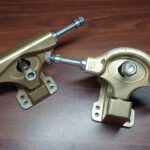Oil leaks are a common problem in older vehicles, especially Jeep XJs. While a small amount of seepage is normal, a significant leak can indicate a more serious issue. This article will discuss common causes of engine seep in a Jeep XJ, specifically focusing on a 2000 model with a cracked 0331 head, and explore various solutions, from simple repairs to engine swaps.
Common Causes of Engine Seep in a Jeep XJ
Several factors can contribute to engine seep in a 2000 Jeep XJ. The notorious 0331 head, known for cracking, is a primary suspect. A cracked head can lead to coolant loss and potentially oil leaks. Other common culprits include:
- Worn or damaged gaskets: The oil pan gasket, valve cover gasket, and rear main seal are common points of failure.
- Clogged oil passages: A buildup of sludge can restrict oil flow and cause pressure to build, leading to leaks.
- Faulty oil pressure sensor: While not a direct cause of leaks, a malfunctioning sensor can trigger a low oil pressure warning, masking the real issue.
Exploring Solutions for a 2000 Jeep XJ with a Cracked Head
Given the cracked 0331 head, several options are available:
Option 1: Using a Pre-2000 4.0L Engine
Swapping in a pre-2000 4.0L engine, while retaining the 2000 intake manifold and ECU, is possible. This requires addressing potential compatibility issues with coil packs and other components. Careful consideration must be given to wiring harness modifications and sensor compatibility.
Option 2: Installing a 2003+ 4.0L Engine
A 2003+ 4.0L engine from a Wrangler or Grand Cherokee (WJ), equipped with the updated TUPY head, offers a more straightforward swap. Researching specific year compatibility for the chosen donor vehicle is crucial to ensure a smooth installation. This option potentially eliminates the 0331 head issue altogether.
Option 3: Rebuilding the Existing Engine
Rebuilding the original 2000 engine with a TUPY head is a viable solution. This involves a complete teardown, inspection, and potential machining of the block and crankshaft. New pistons, rings, bearings, and a thorough cleaning are recommended. However, high machine shop costs can be a deterrent.
Option 4: V8 Engine Swap
While more involved, a 5.3L V8 engine swap provides a significant power upgrade. This requires engine mounts, transmission adapters, and extensive wiring modifications. While potentially more expensive, this option offers increased performance and reliability.
Conclusion
Addressing engine seep in a 2000 Jeep XJ with a cracked 0331 head requires careful consideration of various factors, including cost, time, and desired performance. Each solution presents its own set of challenges and benefits. Thorough research and planning are essential for a successful repair. Ultimately, the best solution depends on individual needs and resources.

